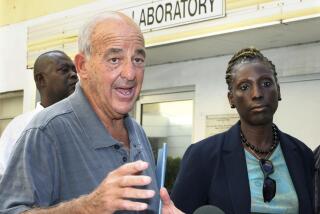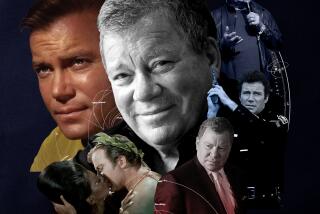Walter Cronkite: ‘Eyewitness to a Century’ exhibit
- Share via
Reporting from Austin, Texas — “Hello, I’m Walter Cronkite.” The stentorian voice booms from an oversize replica of an early console television. To viewers older than 40, the image on the screen is familiar, though more distant with the passing of years. Younger observers appear curious or bemused, or both.
In quick succession, the TV images highlight some of the biggest events of the 20th century. The coverage of the assassination of President Kennedy appears in black and white. Later images from political conventions and Vietnam are in color, before a return to fuzzy, black-and-white footage of Neil Armstrong setting foot on the moon.
Through the tragedy, upheaval and excitement, there is one constant: the essential anchorman. Cronkite. Uncle Walter. The most trusted man in America.
Regardless of the label, the person who provided the dinnertime news on CBS for nearly 20 tumultuous years permanently etched his visage and voice on the minds of millions.
“My father was always home in time to watch the news with Walter Cronkite,” recalls one woman as she makes her way through the exhibit, “Cronkite: Eyewitness to a Century,” at the Lyndon Baines Johnson Library & Museum on the campus of the University of Texas at Austin.
Texas’ capital is an ideal choice for this year’s tribute to America’s most famous newsman. He attended the university here before going on to cover World War II for the United Press news agency.
The university is home to the archives of Cronkite’s life, some of which shape the museum displays.
“When I approached him in the late ‘80s, there was no one probably more famous as a journalist and broadcaster than Walter Cronkite,” says Don Carleton, a noted author-historian and head of the school’s Dolph Briscoe Center for American History.
A child of the ‘50s, Carleton grew up watching Cronkite’s early work on TV shows such as “You Are There” and “The 20th Century.”
“I just was glued to that stuff,” he recalls. “It was probably one of the most important influences on me as a little kid, getting hooked on history.”
The exhibit follows Cronkite through his life, beginning with childhood photos from Missouri and Texas before moving on to various artifacts — including a footlocker on which his name and the words “war correspondent” are stenciled — and several television monitors around which visitors gather to watch the anchorman both on-camera and behind the scenes.
Cronkite’s and President Johnson’s paths passed precipitously in 1968. The story unfolds at the LBJ Museum as visitors move through the galleries devoted to the nation’s 36th president — in particular the space devoted to the Vietnam War.
Cronkite took a camera crew to the war-torn nation early that year. Upon returning, he hosted a prime-time documentary about the conflict. His closing comments play on a museum monitor:
“It has become increasingly clear to this reporter that the only rational way out, then, would be to negotiate — not as victors but as an honorable people who lived up to their pledge to defend democracy and did the best they could,” he intones.
President Johnson didn’t see the documentary when it aired Feb. 27, but after viewing a videotape of it, he told his press secretary, George Christian, “If I’ve lost Walter Cronkite, I’ve lost America.”
Just a month later, on March 31, Johnson went on network television to announce he was de-escalating the war. The original teleprompter script is displayed, complete with LBJ’s bombshell close.
“I shall not seek — and will not accept — the nomination of my party for another term as your president,” LBJ told stunned viewers.
Historian Carleton says Cronkite’s bosses wanted the anchor to deliver his analysis of the Vietnam stalemate on “The CBS Evening News.”
Cronkite, however, refused to allow anything other than facts to be broadcast on the program that he ended each night with his famous signoff, “And that’s the way it is.” Network officials dropped their demand.
“He [Cronkite] wasn’t sure there should be anybody who was the most trusted man in America. We talked about that a lot,” Carleton recalls. “[He worried about] the threat of abuse, someone abusing that.”
Although many younger visitors don’t remember the veteran anchorman, who died last year, Carleton still describes the exhibit as “a multigenerational experience.”
According to the historian, many of the events on which the anchorman reported — which also included the Rev. Martin Luther King Jr.’s assassination and the American space race — helped define a nation.
“Those are truly collective experiences, and that’s why we focused on them,” he observes, adding that, for youngsters, the exhibits appear much more about the events than the newsman.
“They’re sort of experiencing American history beyond Walter.”


